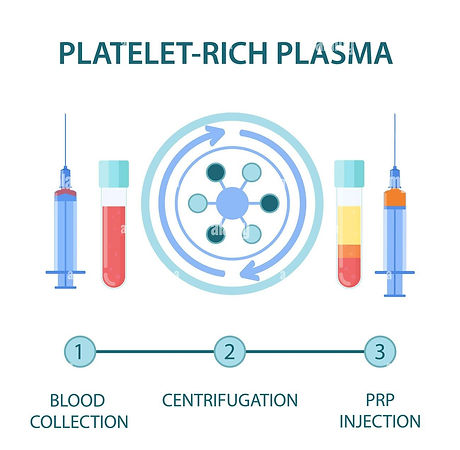
PLATELET RICH PLASMA(PRP)
NeXtGen Medical LLC, offers PRP injections for osteoarthritis and musculoskeletal injuries and treatment option for androgenic hair-loss.
What is PRP?
Platelet-rich plasma consists of two elements: plasma and platelets. Plasma is the liquid portion of whole blood. It is composed largely of water and proteins, and it provides a medium for red blood cells, white blood cells, and platelets to circulate through the body.
Why PRP?
Platelet activation holds a major role in the body's natural healing process.
Platelet-rich plasma (PRP) can be used to treat injuries or damage to tendons, ligaments, muscles, and joints, as such osteoarthritis of the joint. PRP is also utilized as a treatment for androgenic alopecia and in cosmetic treatments.
WHO BENEFITS?
PRP injections can benefit a wide range of people. These plasma injections are platelet-rich and can potentially help the following groups:
Both men and women. Male balding and hair thinning are talked about extensively, but women do not often get the same benefit of widespread information. The fact is that women can lose hair, too, due to several different factors.
Those suffering from androgenic alopecia or other forms of alopecia. This is also known as male/female pattern baldness. It is a hereditary condition that affects around 80 million people in the United States alone.
A sizeable age range of people. Many successful clinical trials have been tested with people ranging from 18 to 72 years of age.
Those who are suffering from hair loss due to high-stress levels. Since this condition is not chronic, it can be treated relatively easily.
Those who have recently experienced hair loss. The more recent the hair loss occurred, the better your chances are of fixing it before it is too late for PRP injections.
Those with thinning or balding hair, but not completely bald people. PRP injections are meant to thicken, strengthen, and grow hair from still functioning follicles, however weakly this may seem.
PRP GENERALIZED PROCESS
Process:
PRP is generated from your own blood; the process for harvest and preparation first includes intravenous access to draw approximately 10-60 mL of blood (depending on the type of treatment) from a vein in your arm. The blood is then centrifuged per the recommendations of the manufacturer being utilized.
A recent Complete Blood Count(CBC) prior to the PRP procedure is required.
PRP injections are done in three steps:
To carry out the therapy, your own blood is drawn from your arm.
That blood is then placed into a centrifuge to spin down into three layers: plasma rich in platelets, platelet-poor plasma, and red blood cells. The PRP will be used, and the rest will be tossed.
That PRP is then injected into a joint (as long as free from joint replacement or free of any surgical hardware) or site or musculoskeletal injury. (Aseptic technique for site preparation; using practices and procedures to prevent contamination from pathogens. It involves applying the strictest rules to minimize the risk of infection).

HAIR LOSS TREATMENT
INJECTIONS ARE DONE IN THREE STEPS
To carry out the therapy, your own blood is drawn, likely from your arm.
That blood is then placed into a centrifuge to spin down into three layers: plasma rich in platelets, platelet-poor plasma, and red blood cells. The PRP will be used, and the rest will be tossed.
That PRP or “blood injection” is then injected into your scalp with a syringe after a local anesthetic has been applied. (Aseptic technique for site preparation. using practices and procedures to prevent contamination from pathogens. It involves applying the strictest rules to minimize the risk of infection).

Before PRP Procedure:
We advise our patients not to use oral or injections of corticosteroids and not to take NSAIDs such as ibuprofen (Advil), naproxen (Aleve), aspirin, meloxicam, diclofenac, celecoxib (Celebrex), or similar medications for 2 weeks before and 6 weeks after the PRP procedure. Acetaminophen (Tylenol) may be used as an alternative. Hydrate well; drinking plenty of water before the procedure helps the blood draw easier.
Directions Pre-Procedure:
Don’t use any hair products like hairspray or gel for at least three days prior to your PRP injections. This can negatively affect you later in terms of side effects.
Don’t smoke or drink heavily beforehand, if at all. This may disqualify you from the procedure, as your platelet count will be lowered significantly.
After PRP Procedure
Resume your normal activities. PRP injections should not incapacitate or inconvenience you in any way. Unlike other procedures, you shouldn’t experience drowsiness or fatigue.
Wash your hair on your normal schedule unless the area of the injections is especially irritated or painful.
Don’t color your hair or get a perm for at least 72 hours after the PRP injections. The harsh chemicals will irritate the site of the injections and possibly cause complications. It also exacerbates scalp pain.
The Recovery Period after PRP Injections:
Every procedure has a recovery time. PRP will not prevent you from doing most normal activities, the side effects and pain in the scalp will typically last for three to four weeks. This is commonly overcome after three to six months.
How often is the procedure performed?
PRP treatments are recommended to be performed once a month for three to four months. After the initial treatment plan, we may request you visit every three to six months for maintenance treatments.
Results, inevitably, vary from patient to patient. But some patients could see results (new hair growth and fewer hairs falling out) within a month.
Post-PRP Side Effects
At NeXtGen, we make known to our patients they may be at risk for some negative side effects following PRP injections. While most of these are not serious, you should always consult your dermatologist if they continue or worsen.
Dizziness
Nausea
Scalp pain
Irritation during the healing process
Scar tissue at the injection site
Injury to blood vessels
Injury to nerves




